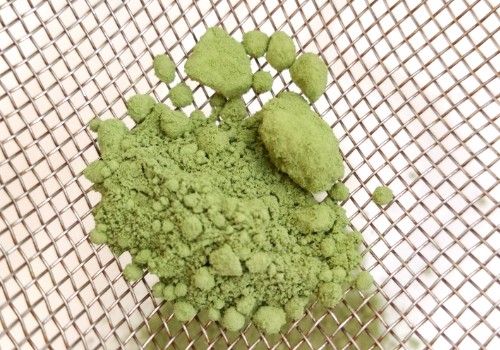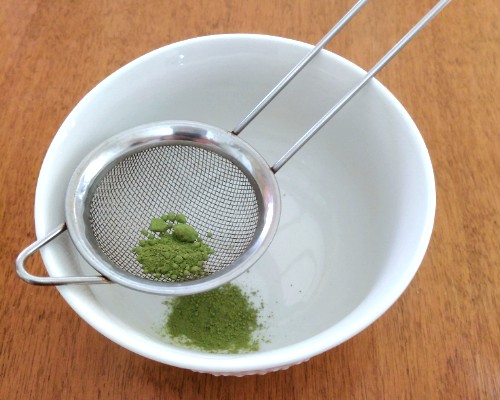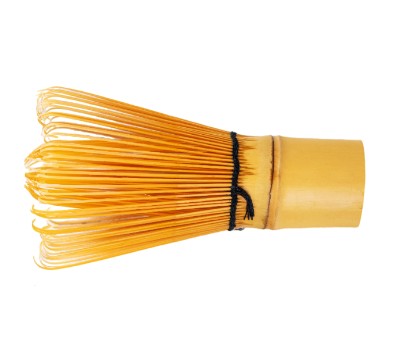If you find that making matcha tea or latte at home results in a strong and bitter taste, don’t worry. There are several ways to make matcha taste good, and I’ll show you how to do it in this post.
High-quality matcha is naturally sweet with a vegetal, refreshing flavor profile and a touch of bitterness. Matcha of the highest quality is almost always less bitter and has a lot of umami, which gives the tea more savory notes.
Now, let’s have a look at what you can do to make your matcha beverage taste like the one described here.
How to Make Matcha Taste Good
In order to get the right matcha taste, whether you’re making a matcha tea with only water or a matcha latte with plant milk, you should:
- Use high-quality matcha
- Start with the recommended matcha-to-water ratio
- Sift the powder
- Use soft water, not hard
- Heat the water to the recommended temperature
- Whisk it properly
- Don’t let it sit too long
Here are the details for each of these tips, which if ignored will result in bitter and bad-tasting matcha.
1. Use High-Quality Matcha Powder
The first and most important step to making matcha taste good is to use high-quality matcha powder. When making matcha tea only with water, use ceremonial-grade matcha instead of culinary matcha.
Culinary-grade matcha, as the name implies, is designed for use in cooking, baking, and smoothies. Making plain matcha tea with cooking-grade matcha results in a bitter beverage.
Ceremonial grade matcha is the most expensive and highest grade matcha. More details on matcha grades can be found here.
When using high-quality matcha powder for plain tea with only water, you can expect a naturally sweet, grassy taste with a smooth, creamy finish.
For matcha lattes, since you add milk, latte-grade matcha should be used. This is cheaper than the ceremonial grade.
Latte-grade matcha can have a strong, slightly bitter flavor when made just with hot water. This matcha grade provides a smoother, less powdered drink when combined with milk and sugar.
To make your matcha tea taste less bitter, the first thing that you should pay attention to when buying matcha for tea is its texture and color.
It should be a very fine powder with a vivid green color and a fresh grassy aroma. If the color is yellowish-green, this is culinary grade, and you’ll end up with a bitter taste.
2. Use the Proper Matcha-to-Water Ratio
The recommended matcha-to-water ratio is 1 gram of matcha (roughly a rounded half-teaspoon) to 70 ml (2.4 oz) of water, or 1:70. You can start with this and then adjust it according to your taste.
If the taste is too intense, simply add more water.
3. Sift the Powder
Another crucial step in making your matcha tea taste good is sifting the matcha powder. It appears to be a little step that can be skipped, yet it is important.
When using matcha powder, sift it to achieve a smooth, frothy, full-bodied tea. Unsifted matcha is typically grainy and weak in taste.
Since this is a fine powder, it tends to clump together. These clumps do not dissolve in water.

Sifting the powder is the only option to break up the lumps.
Otherwise, some of the lumps will survive whisking and reach the surface of the whisked matcha. This has a negative impact on the appearance and taste, too.
It’s so simple—just sift the powder through a sifter shortly before preparing your cup of tea. A standard tea strainer or sieve will work.
To avoid contaminating the powder with other undesirable flavors, keep a separate strainer only for sifting matcha.
Only sift the amount of powder that you’ll use at the moment. It is not recommended to sift your matcha powder and then not use it since it will clump again

4. Don’t Use Hard Water
The best water for making matcha that tastes great is soft, spring water with a pH of 6.5-7.
Softer water is preferable to hard water since it brings out the best flavors and aromas of matcha.
Hard water can weaken the beneficial astringents in matcha tea and reduce its aroma. Astringency is a mouth-drying sensation that gives matcha its distinct mouthfeel.
If you use tap water for making matcha, always make sure to filter it. Don’t use distilled or mineral water for making matcha tea or any other tea.
5. Use Hot, Not Boiling, Water
The biggest mistake in brewing matcha tea is using boiling water. Boiling water will scorch the powder, resulting in bitter, bad-tasting matcha.
The ideal water temperature for preparing matcha tea is 175°F (80°C). Cooler water, no lower than 140°F (60°C), can be used, but never boiling water.
Since this is an important factor that heavily affects the final taste of your matcha drink, here is a detailed article on the ideal matcha water temperature.
6. Whisk it Well
The secret to frothy, tasty matcha is to whisk it, not stir it. Whisking increases aeration. This allows the water and matcha to mingle with the air, producing a frothy top.
To whisk matcha properly, use a bamboo whisk, also known as “chasen” in Japanese.
It’s light and flexible, and it won’t scratch the bowl. Also, the bamboo whisk does not interfere with the taste of the matcha.

To properly whisk the powder into the water, begin at the bottom of the bowl and gradually work your way up.
You should vigorously whisk the matcha and water to get the frothy, creamy texture of traditional matcha. Start making an M or W shape with the whisk.
Circular stirring is too smooth and does not oxygenate the tea; no bubbles form.
Whisk until the powder is completely suspended and no big bubbles remain. 20 seconds should be enough.
Finish by softly whisking the top once you’ve achieved a nice volume of foam. This helps in the formation of a thick foam.
Whisking matcha is not complicated, but it does require some practice (when you start preparing matcha tea on a regular basis, it’ll become part of your routine).
If you don’t have a matcha whisk, a milk frother, shaking the tea in a jar, or a cocktail shaker would work. You’ll get foam in both cases, but some clumps will remain, which is not good for the taste.
Matcha prepared with an electric frother will be less creamy and thinner than matcha made with a bamboo whisk.
To prevent splashing while using a milk frother, use a higher glass and only fill it halfway.
7. Consume Matcha Right After Preparation
Matcha is a delicate beverage that quickly loses flavor and freshness if not consumed right away.This is especially important when making matcha tea with only water.
If you leave matcha tea sitting for too long, the froth can separate from the liquid, and the texture can become lumpy or grainy.
This results in a bad appearance and a less enjoyable drinking experience. Finally, it has a negative impact on the overall flavor of the tea.
Hence, if you followed all of the above guidelines and made a perfect matcha beverage, don’t let it sit for too long. Drink it shortly after preparing it to experience the full flavor and freshness that matcha has to offer.
What Should I Use to Sweeten Matcha?
You may sweeten matcha with a variety of sweeteners, including:
- Stevia
- Agave syrup
- Sugar
- Honey
- Maple syrup
Whatever sweetener you decide to use, it will affect the matcha tea’s flavor profile. You won’t have to add any sugar to matcha if you follow the aforementioned steps to make it taste great.
The ideal way to drink matcha tea is without sweetener, but if you must, try eating something sweet instead of ruining matcha’s flavor with a direct sweetener.
Before your daily bowl of matcha, you can have a small bite of chocolate. When dark chocolate is consumed before drinking matcha, the matcha’s flavor characteristics are enhanced.
Another wonderful treat to pair with your matcha tea is white chocolate.
It provides just enough sweetness to balance out the bitter notes of the matcha. Also, white chocolate doesn’t have a flavor that overpowers the matcha flavor.
Therefore, when it comes to eating something sweet to improve the taste of matcha, white chocolate may be the ideal choice.
What to Pair With Matcha to Make It Taste Better
Matcha pairs well with something sweet. I’ve mentioned that dark and white chocolate pair best with matcha and minimize its bitterness.
In addition to chocolate, these foods also go well with matcha:
- Wagashi (sweet confections, traditional pairing for matcha in Japan)
- Milk (oat milk is extremely popular these days for matcha lattes)
- Citrus fruit (the taste of matcha becomes stronger; many people don’t like this combo)
- Frozen yogurt (vanilla flavor is a good choice)
You can try any other sweet treat and decide which one is best for you. Usually matcha doesn’t pair well with fruit pies or chocolate cakes. Also, unsweet treats don’t go well with matcha.
Always start with a small amount of any food and adjust to your liking. With a little testing, you can find the perfect food that goes well with matcha according to your taste.
FAQ
Is matcha better with water or milk?
It’s a matter of personal preference. Matcha made only with water has a mellow, grassy taste accompanied by a naturally sweet nuttiness with a touch of bitterness. Matcha with milk has a creamier texture, a slightly sweeter flavor, and less bitterness.
Why does my matcha taste powdery?
Your matcha drink may taste powdery for several reasons: not whisking it properly, using too much matcha powder, using the wrong type of whisk, or using low-quality matcha powder.
What does iced matcha taste like?
Iced matcha made only with cold water, ice, and matcha powder has an earthy, grassy flavor with a slight bitterness and, at the same time, a refreshing and cooling taste. The bitterness is less pronounced, and the overall taste is milder than when it’s served hot.
How do I store matcha to preserve its flavor?
To preserve its flavor, matcha should be stored in an airtight container in a cool, dry place away from light and moisture. If you don’t store your matcha properly, it will lose its color, freshness, and taste.
The Takeaway
If you’re unhappy with the taste of your homemade matcha beverage, simply follow the tips offered here, and I’m sure you’ll improve the taste of your matcha tea or latte.
Be super careful about the quality of the powder you choose; here is where most people go wrong.
Likewise, pay attention to the water temperature and ratio, sift the powder, and whisk it well for a delicious matcha drink.
The final step is super important; drink it immediately after preparing. Don’t let matcha sit out!
With a little effort and testing, you’ll be able to make matcha taste great. Who knows, maybe matcha will become your new favorite beverage!

